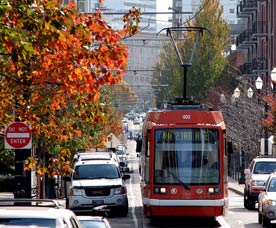
A streetcar in Portland, Oregon. Photo by Flickr user Phillip Salzman
This contribution arrived via time capsule from Aug. 28, 2020:
Looking back, the signs should have been obvious: After decades of decline, city populations stabilized during the 1990s and even started to increase in many locations during the 1990s and early 2000s. The sharp increase in fuel prices in 2005-2008 accelerated the return of higher-income households, as they sought to sharply reduce their car use to cut transportation costs and reduce their carbon emissions. Despite a housing market that was generally weak, the development of high-end condominiums near public-transit stops and job centers took off in the late 2000s to accommodate demand for walkable communities with low transportation costs.
By the early 2010s, the trend was well established: skyrocketing housing prices near public transit and attractive city and job centers, and increased displacement of low- and moderate-income households from these neighborhoods. The displaced often had little choice but to relocate to the urban fringe where housing was cheap — indeed, often depreciating — but transportation costs so high that many could not afford to get to work. By 2020, what had seemed unimaginable only 15 years earlier was now a reality: America’s cities had once again become the domain of the wealthy — inverting the housing patterns of the second half of the 20th century.
While this trend has greatly helped cities’ finances, it has been devastating for low- and moderate-income households, who are now excluded by high housing prices from the urban core and desirable areas with good public-transit access. For many, transportation cost burdens have replaced severe rent and mortgage costs as their dominant housing problem, though rising utility prices also loom large.
The real tragedy is that this could easily have been prevented. The increased demand for housing near public-transit stops and job centers caused by rising energy prices created a tremendous windfall for property owners. Had the government acted in the late 2000s to capture some of that increased value through inclusionary zoning requirements or incentives, or by adapting tax-increment financing mechanisms to these energy-efficient locations, they could have created housing opportunities that would have been affordable to low- and moderate-income families with minimal public expense. Through permanent rental affordability covenants and shared-equity homeownership arrangements that keep homes affordable while still allowing individuals to build equity, communities could have preserved these affordable housing opportunities as resources for the future. Investments in energy-efficient rehabilitation of older homes and the preservation of affordable rental housing in these energy-efficient locations could further have helped maintain affordability.
Alas, most state and local governments failed to take these logical steps — in part, because they didn’t fully appreciate the magnitude of the situation, and in part because of the usual political obstacles to expanding the supply of affordable housing. With poverty on the rise, the federal government finally acted in 2018 to double the federal housing budget to purchase homes in these energy-efficient locations to ensure their affordability. But this was too little and too late. It would have been far cheaper and more effective to have acted 10 years earlier.
In retrospect, the single most important missed opportunity was the reauthorization of federal transportation and infrastructure funding in 2009. It would have been simple at that time to build in strong financial incentives for communities to expand the supply of homes permanently affordable to families with a mix of incomes near public-transit stops and job centers. Congress could simply have said: if you want to maximize your federal transportation funding, you need to ensure that families of all incomes have access to homes in these locations. Communities could then have determined which approach they wished to take: low- or no-cost approaches like inclusionary zoning or tax-increment financing, or other approaches that might require more subsidy. It would not have cost the federal government a dime, yet would have created powerful incentives for local communities to build in affordability at the outset of the boom in transit-oriented development and more compact development around job centers.
There was a broad coalition called T4America that advocated for these and other changes to the transportation-funding bill in 2008 and 2009 to maximize the benefits the nation achieved through its investments in transportation infrastructure. In addition to promoting financial incentives for affordable homes near public-transit stops and job centers, the T4America coalition argued that the nation’s transportation funding policies should promote more compact development, walkable and bikable communities, and increased investments in public transit to allow families to reduce their reliance on cars and to reduce the nation’s energy usage and greenhouse gas emissions. They made a compelling case for change, but were ultimately defeated by special interests seeking to preserve the status quo.
If only America had listened . . .




Comments